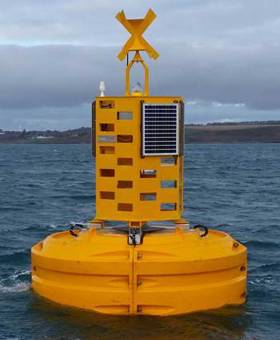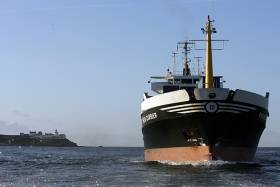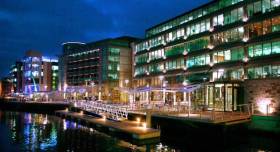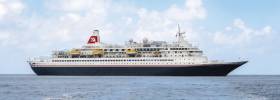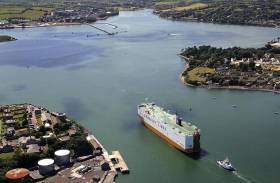Displaying items by tag: port of Cork
Wave Data Buoy Deployed at Port of Cork
TechWorks Marine has deployed an operational Wave Buoy by Port of Cork in late 2016, to be deployed at Roche’s Point on the approach to Cork Harbour.
As the Wave climate in Ireland takes its toll on equipment, a large platform was recommended in order to survive the heavy weather, and maximise visibility of the data buoy to the shipping activity using the harbour on a daily basis.
Central to this development is the TechWorks Marine TMBB-Data Acquisition and Transmission system, the versatile and configurable monitoring platform is designed around it. The TMBB is a robust, reliable and scalable data acquisition system, which ensures the ongoing collection and transmission of quality assured data to enable clients to make informed decisions linked to their commercial activity. Already operational, data is being transmitted in real-time every 20 minutes to the Port of Cork Operations station. The inertial wave sensor used on the buoy is the SeaView Systems SVS-603. The Mobilis Jet9000 buoy Hull was selected as the most robust and reliable platform for such long term operational deployment.
The engineering team at TechWorks Marine carried out the full system integration and testing and extensive onsite training was provided, combined with detailed hardware and software documentation. The TechWorks Marine Data buoy can be easily upgraded in the future with additional Meteorological and Oceanographic sensors given the modular structure of the TMBB system.
Ms Charlotte O’Kelly, CEO of TechWorks Marine confirmed that the Wave buoy was deployed operationally in early December following initial on-site testing by TechWorks Marine. Ms O'Kelly said: ‘At present, the data buoy reports directly to the Port of Cork operations centre from where its data is used to ensure the safety of ships coming in and out of the Harbour.’
Port of Cork Harbour Master, Captain Paul O Regan commented on the wave buoy saying: ‘To date the wave data we have collected has been extremely useful with regards to our shipping operations. Safety is our first priority at the Port of Cork and this technology will assist us as we see larger vessels arriving into the port.’
Cork Docklands Site Comes To Market
#CorkHarbour - More than three acres of Cork docklands are coming to market, as the Irish Examiner reports.
The lands comprise a warehouse property between Monahan Road and Centre Park road east of the city centre, in an area already set for transformation between the revamped Páirc Uí Chaoimh and the new Marina Park regeneration project, adjacent to Cork City Marina by the former showgrounds.
Commercial and residential developers alike are expected to express interest in the 3.31-acre site, zoned for mixed use, and with a guide price of €1.2 million per acre.
Interest in this part of the city is growing with the imminent move of the Port of Cork downriver — and city planners are already meeting with potential buyers for the port’s historic buildings on Custom House Quay.
The Irish Examiner has more on the story HERE.
Podcast – Meitheal Mara Plan For Cork & A Voyage for Mad Men
Hello there and welcome aboard this week’s edition of Seascapes the maritime programme, this week we hear about the future plans of Meitheal Mara; we have music from Gordon Lightfoot and the epic tale of “The Wreck of the Edmund Fitzgerald” and a talk in the Poolbeg Yacht and Boat Club in the coming week titled “A Voyage for Madmen – the Golden Globe Race- 1968 to 2018 “ with Gregor McGuckin who has entered next years edition of the race, writer and broadcaster Norman Freeman takes us on a visit to Bray Head in County Wicklow , we have the winner in our Seascapes competition for that book on the “ Rivers Dodder and Poddle”....first this week on your maritime programme we hear about the future strategic plans for Meitheal Mara based in the heart of Cork city , the plan was launched in the splendid boardroom of The Port of Cork by Minister Simon Coveney TD ,Meitheal Mara was founded in 1993, the event was attended by over one hundred partners , supporters and sponsors of the organisation, in a moment we’ll hear from John Mullins CEO of The Port of Cork and from Chief of Staff of the Defence Forces, Vice Admiral Mark Mellett....Meitheal Mara is a maritime heritage community for young people and adults, we talked first to one of the founders , seafarer boatman and boat builder and maritime advocate Padraig O Duineen .....
Well from Padraig O Duineen of Meitheal Mara to John Mullins , CEO of the Port of Cork .....
The voice of John Mullins, Chairman of the Port of Cork Company, next to the Chief of Staff of the Defence Forces – Vice Admiral Mark Mellett
Vice Admiral Mark Mellett at that launch of Meitheal Mara’s Strategic Plan for the coming years which was launched last Friday afternoon , you can read more about the organisation here.
Next here on Seascapes to the East coast and writer and broadcaster Norman Freeman on Bray Head.....
Writer and broadcaster Norman Freeman whose latest book “The Lure of Far Away Places “ is published by The Liffey Press and in all discerning bookstores.
We recommend you see Eugeen Van Mieghem – An exhibition of his paintings in ” Port Life “ at The Hugh Lane Gallery described as a fascinating visual account of the pulsating life of a working port at the beginning of the 20th century.
Van Mieghem’s work represents a social history, exploring themes of migration, globalisation, port society, the working community, and, the life of the artist .
Organised with the support of Dublin Port Company, the exhibition is part of Port Perspectives, Dublin Port’s arts commissioning programme to help re-establish links between the Port and the City.
The exhibition can be viewed Tuesday to Thursday 9:45 am – 6 pm, Friday 9:45 am – 5 pm, Saturday 10 am – 5 pm and Sunday 11 am – 5 pm. Admission is free of charge (voluntary contributions to the Gallery are appreciated).
Next to an epic song on a maritime disaster from the pen of songwriter supreme Gordon Lightfoot and “The Wreck of the Edmund Fitzgerald”
The wreck of the Edmund Fitzgerald” written and performed by Gordon Lightfoot.....
The Department of Transport, Tourism and Sport has launched its new Seafarers web resource for all seafarers, fishers, recreational craft users and others looking to obtain certification or qualification in the sector.
The new website they state is “ intended as a national and international resource for information relating to seafarers, which includes those involved in commercial shipping, the fishing industry and the recreational craft sector.”
The site provides full details of the career structures available and how to obtain the necessary qualifications for work in the industry, as well as for recreational craft users.
The website hosts all appropriate application forms and also provides for the verification of qualifications, listing details of approved training course providers in Ireland.
The Department of Transport , Tourism and Sport says the Seafarers website forms part of a wider updating of seafarer education and training in Ireland, and is supported by a new Seafarers Information System, which provides for the registration of all seafarers and for life-long training and career development.
The department encourages seafarers who already hold Certificates of Competency or radio certificates issued in Ireland to register now on the new information system.
"A Voyage For Madmen"- The Golden Globe Race 1968-2018. An illustrated lecture by Gregor McGuckin, who has entered for the 2018 race, will take place on Thursday 2nd February at 20:00hrs at the Poolbeg Yacht & Boat Club, Ringsend,. There will be an entry fee of €5 in aid of the RNLI.
World Wetlands Day is coming up on February 2nd , and this year’s theme is ‘Wetlands for Disaster Risk Reduction’.
Wetlands play a vital role in mitigating the impact of extreme weather events.......that’s next Thursday “World Wetlands Day.....”
Finally to our Seascapes competition and the copy of “The Rivers Dodder and Poddle - Mills , Storms and Droughts and the Public Water Supply” by Don McEntee and Michael Corcoran and published by Dublin City Council and Four Courts Press - the first correct answer out of the Seascapes fedora was from Tessie McGettigan , Lifford , Co Donegal , Congratulations that book is on its way to you......many thanks for all your entries....
“ On the sound desk on Seascapes this week Bryan Fitzpatrick , next week here on your maritime programme we bring you a full report from the Volvo –Irish Sailing Association Annual Awards at the Royal Dublin Society Concert Hall in Ballsbridge , where they will present the ISA Training Centre of the Year ; Youth Sailor of the Year ; Afloat.ie Sailor of the Year and the ISA President's Awards; all that and much more .......so until next Friday night, tight lines and fair sailing.”
Irish Sailing Association Host Cruising Conference in Port of Cork
The Irish Sailing Association’s 2017 Cruising Conference takes place this year on Saturday, 18 February at the historic Port of Cork offices in Cork city.
The conference is a chance for sailors to hear and discuss the latest knowledge and insights from marine experts, as well as network with a community of their peers. It is sponsored by Union Chandlery and supported by the Cruising Association of Ireland.
This year’s line-up of speakers include Ballymaloe chef Rachel Allen who will discuss recipes from her cookbook “Coast” and look at all the food available along Ireland’s Atlantic coast, from Cork to Donegal.
The conference will also hear from the RNLI (and how to avoid them at sea), the latest research from Irish Lights, stories from a woman-over-board, as well as learn about predicting the weather, unusual tides, and tales on surviving a round-the-world cruising trip.
Tickets for the conference are available here
Port of Cork Handles 9.2m Tonnes Of Trade
Total traffic through the Port of Cork reached 9.2 million tonnes in 2016, a slight decrease compared to 2015 traffic. Import figures remain steady while exports were reduced primarily due to the closure of Lisheen Mines in Co. Tipperary and the subsequent cessation of exporting lead and zinc through the Port of Cork in 2016.
Total container volumes through both Tivoli and Ringaskiddy Container Terminals grew by 2% compared to 2015 figures, with over 209,000 TEU’s handled. The growth in container handling at the Port of Cork is very encouraging particularly as the Port moves to redevelop Ringaskiddy Port as their main container terminal. In 2016 the largest container vessel to visit an Irish Port called to Ringaskiddy on route from Central America. This weekly service not only ensures the Irish grocery market is fully supplied with fresh fruit, but positions Cork as deep sea port capable of handling panamax size container vessels.
Trade in Dry bulk cargos such as animal feed, fertilisers and cereals saw a marginal decrease while liquid bulk cargo, predominantly the oil traffic handled through Whitegate Oil Refinery now Irving Oil, also reported a slight decrease. Positively, in 2016 family owned Canadian company Irving Oil acquired Phillips 66, securing the future of Whitegate Oil Refinery. This positive step was welcomed by the Port of Cork and will ensure Ireland remains competitive within the global oil market and has a security of supply of crude products that can be refined within the Irish State and not be totally dependent on international events. Whitegate supplies 30-40% of the Irish refined fuel market through its road loading facility and by sea to Irish and international ports over its marine jetty.
Speaking about the 2016 trade traffic figures the Port of Cork Chairman Mr. John Mullins said: ‘The trade results for the Port of Cork in 2016 are overall very encouraging despite some decreases in certain trades. We are very pleased with the results as achieving traffic figures which are in line with pre-recessionary time highlights the positivity returning to the market and I am confident that the port can sustain this growth across 2017. In particular container traffic through Tivoli and Ringaskiddy increased by 2% with imports fractionally higher than exports. There was impressive growth in the imports of trade cars with over 46,000 vehicles imported.’
He continued: ‘In addition to the overall trade traffic figures, the Port of Cork’s cruise business has gone from strength to strength with a total of 58 liners visiting Cork during 2016. This high number of calls brought over 127,000 passengers and crew, helping to drive visitors to the region. Furthermore, in 2016, Cobh was named the second Best Cruise Destination in the British Isles & Western Europe in the first-ever Cruise Critic Cruisers’ Choice Destination Awards, which we are immensely proud of. In 2017 69 cruise liners are scheduled to call and 2018 is looking even stronger.’
2016 saw Brittany Ferries operating another successful year with their service from Cork to Roscoff carrying almost 80,000 passengers in 2016 and it is anticipated that 2017 will be another busy year for Brittany Ferries when sailings resume in March.
In 2015 An Bord Pleanala granted a 10-year planning permission to Port of Cork for the redevelopment of the existing port facilities at Ringaskiddy. In July 2016 the Port of Cork submitted to the Board a request to alter the terms of the permission granted to enhance the long-term sustainability of the port. The €80 million port redevelopment will future proof the facility and Port of Cork look forward to the project progressing in 2017.
Safehaven’s ‘Thunder Child’ Put Through Its Paces In Stormy Cork Harbour
#ThunderChild - Stormy winter seas made the perfect proving ground for a new state-of-the-art naval patrol and rescue vessel tested in Cork Harbour recently, as the Irish Examiner reports.
But it’s just the beginning for Thunder Child – the latest high-tech design from Cork-based Safehaven Marine, makers of the James Bond-style Interceptor, Barracuda – which was launched from the Port of Cork last month.
Safehaven’s managing director Frank Kowalski has his sights set on breaking the record for the fastest circumnavigation of Ireland — including a 1,000km open-sea loop around Rockall.
And considering the sleek wave-cutting vessel has already clocked speeds of over 100kph in testing, and is kitted out to handle the stormiest situations, it should be well up to the task of that challenging route.
The Irish Examiner has more on the story HERE.
Cork 'City Quarter' Boardwalk In €14m Deal
#CityQuarter - In a deal worth up to €14m writes The Irish Examiner, is to be signed in the coming days on a remaining investment — including the Boardwalk bar and restaurant — at Cork city’s seminal City Quarter.
It went to market for Nama in September 2016, guiding €14.5 million.
The investment offer, including remaining 38,000 sq ft of offices, basement car parking and ground floor space at the €100m City Quarter, is close to being bought in one single lot, according to sources. It has an income of €654,000 with scope to double that to €1.33m, according to Savills.
It’s understood that one investor is behind the impending deal, and when concluded, it may involve a re-sale or sub-sale as well as leases of several of the key components.
Click here for more on the deal at the site which Afloat adds is directly opposite to Ardmore Shipping Corporation's 'Irish' office on Albert Quay.
The Bermuda headquartered corporation of a product/chemical tanker fleet, relocated last summer its principle operating office to Cork City from the suburb of Mahon downriver.
Last month several key appointments were made by Ardmore to their offices in Singapore and Houston, USA.
Quartet of Cruiseships Coming to Cork for Christmas
#CobhChristmasCall - A quartet of cruiseships will come to Cork Harbour this festive season, including one on Christmas Day, bringing 5,000 visitors to the region.
The increase writes the Evening Echo in winter cruiseships highlights a changing industry. Cork traditionally welcomes cruiseships into Cobh from April to October, and 58 vessels arrived this year.
The larger ocean liners are then redeployed to the Caribbean, the Meditteranean, or to the southern ocean around Australia. However, increased competition means vessels operated by UK and German cruise companies are continuing in northern Europe throughout the winter.
Earlier this week, the Bodicea called to Cobh and will be followed by the Balmoral, on Saturday, and the Marco Polo, on Monday. Then, on Christmas Day, Black Watch, operated by Fred Olsen Cruise Lines, will come to Cobh. The four vessels have a capacity of 5,600 passengers and crew.
For more from Captain Michael McCarthy, the commercial manager of the Port of Cork, click here.
Shipping Snapshot: Cork Harbour's Diverse Range of Vessels
#PortSnapshot - Shipping movements in the Port of Cork have included in recent days a diverse range of vessels that are based and have visited the natural harbour, writes Jehan Ashmore.
Outlined below are vessels that Afloat.ie have tracked and their respective business activity.
Kinsale GasField Supply Support Ship: Ocean Spey a supply tug support vessel, newly introduced at the Kinsale Energy Ltd facility (formerly Marathon Oil) is currently operating offshore. The 66m vessel is reported to be registered in Ireland and is serving the pair of gas rig platforms located approximately 50kms off the south coast of Cork. Afloat will have more to report on Ocean Spey.
The vessel which also has anchor handling capabilities was built in 2000 and has a 1,864 gross tonnage. Meanwhile the main Kinsale Gasfield standby support ship, Pearl, operated by Cork based Mainport Group, (owners subsidiary Seahorse), is currently at the lay-by berth at Cork Dockyard, Rushbrooke near Cobh.
Brittany Ferries Flagship Service: Pont-Aven, Brittany Ferries flagship of 41,700 gross tonnage made her final Cork-Roscoff end of season sailing on Saturday.
In advance of the season the cruiseferry was fitted with 'scrubbers' to reduce harmful sulphur emissions (the only ferry in Irish waters with this 'green' technology as previously explained here).
The Ireland-France route began in 1978, the same year gas was first produced from the Kinsale Head area in the Celtic Sea. The 2,400 passenger/650 car ferry is to resume service in April, 2017.
Dutch Naval Submarine: A more unusual sight to Cork Harbour has been submarine HNLMS Bruinvis of the Royal Netherlands Navy (NATO member). The non-nuclear powered 68m submarine built during the Cold War is equipped with almost 40 torpedoes missiles.
The crew having paid a visit to Cork City for a long weekend departed yesterday using its diesel electric engines.
Photographs Needed for Port of Cork 2017 Calendar
Every year the Port of Cork Company compiles a much sought after calendar of Port and harbour photos. Over the years the themes and designs have varied from old style maritime paintings, historic photos of the port demonstrating the ports history and Cork Harbour as a trade gateway, to photographs of today’s port, a modern dynamic and busy facilitator of imports and exports.
With so many trade and leisure visitors to our Port, every day is different and thanks to some keen photographers out there, much of this activity is captured in photographs and shared via social media.
The Port of Cork is now compiling the calendar for 2017 and is inviting photographers both amateur and professional, if interested to submit a photo. All photos should be port activity or Cork harbour related. Fourteen photographs will be selected for the calendar and photographers whose photos are chosen will receive a copy of the Port of Cork calendar and a credit within the calendar.
The calendar is printed and distributed compliments of the Port of Cork to port users and customers. Every year over 1000 calendars are distributed.
If you are interested in submitting a photograph (max 2 photos per submission) please send your images to Sara MacKeown [email protected] along with your name and contact details. All images must be landscape and high resolution Jpg format. Closing date for submissions 17th November.





























